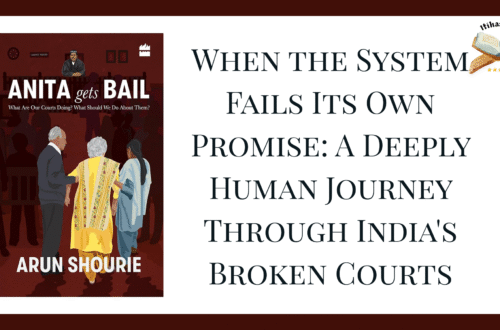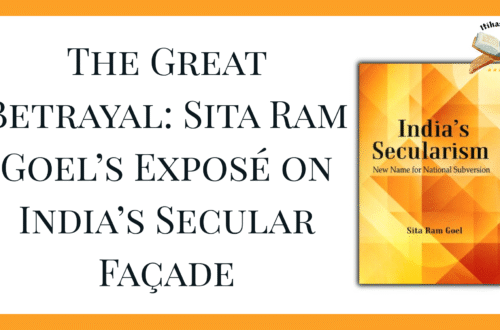
Whose History Is She Really Telling? A Critical Look at Romila Thapar’s Marxist Lens
Romila Thapar, long revered within elite academic circles and international liberal platforms as the authoritative voice on Indian historiography, positions her work, Our History, Their History, Whose History?, as an ostensibly impartial inquiry into the political utilization of historical narratives. However, when viewed critically through an Indic right-wing lens, Thapar’s slim but ideologically dense volume emerges less as detached scholarship and more as a carefully orchestrated defense of a Nehruvian-Marxist historiographical paradigm that continues to dominate Indian academia decades after its ideological apex.
Central to Thapar’s narrative is the contention that nationalism inherently distorts historical interpretation. Ironically, this critique fails to confront her own implicit nationalist biases favoring the Nehruvian secular nation-state, a state whose ideological architecture was significantly shaped by a particular brand of selective secularism. Arun Shourie’s comprehensive critique in Eminent Historians: Their Technology, Their Line, Their Fraud meticulously details how historians like Thapar systematically tailor evidence to uphold ideological prejudices, notably marginalizing Hindu historical perspectives in favor of accommodating Islamic and missionary narratives. This glaring selective objectivity effectively undermines the very premise of neutrality that Thapar claims to champion.
This ideological posture becomes even more evident in Thapar’s recurrent dismissal of civilizational motifs intrinsic to the Hindu worldview. Her work reflects an allergy to concepts like dharma, karma, and tirtha-kshetras, which have constituted the backbone of India’s cultural continuity. Instead, she prefers the familiar Eurocentric binaries of oppressor and oppressed, class and capital, colonizer and colonized. The irony, of course, is that in fighting colonial epistemologies, she embraces one herself: Marxism, a European ideological framework foreign to Indic metaphysics. This creates an absurd situation where a civilizational narrative rooted in spiritual inquiry and philosophical diversity is reduced to a Marxist soap opera.
Thapar’s selective historiography becomes strikingly apparent in her handling of Islamic invasions of India. Her tendency to diminish the brutality of Islamic conquests, rationalizing them primarily as political pragmatism rather than religious iconoclasm, starkly contrasts with the extensive documentary evidence provided by Sita Ram Goel in Hindu Temples: What Happened to Them. Goel’s meticulous documentation of temple destructions, forced conversions, and cultural annihilation provides irrefutable evidence of religious violence that Thapar and her ideological cohort frequently dismiss or downplay. This ideological oversight is emblematic of Thapar’s broader historiographical approach, which persistently frames Indian history within the Marxist lens of class struggle, even in contexts where such interpretations are historically incongruent or altogether absent.
Even more revealing is the treatment of the Bhakti movement. Thapar’s framing reduces it to a reactionary response against caste oppression, entirely stripping it of its Upanishadic roots, metaphysical profundity, and emotional intensity. Saints like Mirabai, Tukaram, and Andal become unwitting participants in a socialist revolution they never signed up for. Here, the richness of India’s spiritual expressions is forced into the grey uniformity of ideological convenience. Thapar’s Bhakti is secularism in disguise, a Trojan horse for Marxist ideas.
Moreover, while Thapar rightfully critiques James Mill’s colonial-era periodization of Indian history into Hindu-Muslim-British epochs, her historiographical legacy inadvertently reinforces the very schema she ostensibly seeks to dismantle. NCERT textbooks shaped under her influence systematically minimized the intellectual and scientific achievements of pre-Islamic India, relegated Bhakti movements to mere expressions of social dissent devoid of profound metaphysical roots, and systematically obscured the widespread cultural violence perpetrated during Islamic and British rule. Such historiographical choices perpetuate the colonial narrative under the guise of Marxist progressive historiography, ironically sustaining the colonial framework they purport to critique.
Furthermore, Thapar’s critique of the recent rewriting of textbooks as an exercise in “saffronization” rings hollow when one considers her own decades-long involvement in academic gatekeeping. As documented by Arun Shourie, the NCERT revisions of 2005, undertaken during the UPA government’s tenure, essentially amounted to a sanitized retelling of history where invasions were softened, heroes deconstructed, and indigenous knowledge erased. Thapar never seemed to mind that textbooks reduced Ayurveda to superstition or the Vedas to primitive chants. But she now raises the alarm when Yoga, Sanskrit, or temple architecture are given their due. The real concern, then, appears not to be historical accuracy but the erosion of monopoly.
Indic scholars like Meenakshi Jain have painstakingly exposed how these textbooks omit references to major contributions by ancient Indian scientists, mathematicians, and philosophers: Aryabhata, Kanada, Sushruta, and others are either glossed over or entirely ignored. Jain’s Medieval India provides a clear rebuttal to this pattern, emphasizing the continuity of Indic knowledge systems and the unique civilizational lens through which India must be viewed. Ignoring these contributions is not merely academic negligence, it is cultural sabotage.
Additionally, the Eurocentric and Perso-Arabic reliance in Thapar’s historiography further compounds this exclusion. Indigenous sources such as temple records, oral traditions, kavyas, and itihasa are either deemed unreliable or mythological, while Persian court chronicles of the Mughals are treated as gospel. The result is a historical narrative where foreign accounts are deemed credible and native voices systematically invalidated, a bizarre academic Stockholm syndrome.
This disdain for indigenous sources is precisely what Sita Ram Goel challenged when he publicly asked Marxist historians, including Thapar, to publish a refutation of his two-volume work on temple destruction. They didn’t. They could have issued counter-evidence, debated methodology, or published a rebuttal. Instead, they responded with silence. The lack of engagement was telling: when faced with facts that contradicted their worldview, the response was academic excommunication.
Thapar’s discomfort with the idea of civilizational continuity also explains her preference for framing India solely through the lens of the modern nation-state. The idea that India could be a civilization-state, a cultural entity older than most modern nations, is either ignored or mocked. Her historiography has no space for the epics, for the tirtha-circuits that connect Kashi to Rameshwaram, or for the philosophical evolution from Rig Vedic hymns to Vedanta. For Thapar, history begins with the Mauryas and ends with Nehru.
But a growing body of scholarship challenges this reductionism. Kalhana’s Rajatarangini, the travelogues of Al-Biruni (ironically more respectful of Indian traditions than Thapar), and archaeological evidence from sites like Dholavira and Keezhadi demonstrate a level of sophistication in ancient Indian society that far surpasses the linear Marxist model of feudalism-capitalism-socialism. Yet, these evidences are rarely foregrounded in Thapar’s works, where the preferred sources are colonial administrators and Persian chroniclers.
Emerging Indic Academia
What Thapar’s intellectual successors did not anticipate was the emergence of a robust Indic academic alternative, one that blends rigorous research with civilizational rootedness. Institutions like the Indic Academy, scholars like Vikram Sampath, Sanjeev Sanyal, and Anuradha Goyal, and platforms like Swarajya, IndiaFacts, and the Dharma Dispatch have begun reclaiming historical narratives with methodological precision and unapologetic confidence. They do not merely oppose Thapar’s narrative, they transcend it. By rooting historical inquiry in Sanskrit texts, regional traditions, temple archives, and archaeology, they have begun dismantling the twin scaffolds of colonial and Marxist historiography.
This growing scholarship, driven by a younger generation less beholden to Western academic gatekeeping, is increasingly peer-reviewed, data-driven, and inter-disciplinary. It combines history with cultural anthropology, linguistics, genetics, and digital humanities. Most importantly, it asks the unthinkable question: What if India was never really a nation-state, but always a civilizational state whose story cannot be told within the stifling binaries of Western political thought?
Reverence Abroad, Relevance in Decline?
Thapar’s academic footprint abroad remains formidable, her lectures at Oxford, Columbia, and Harvard still draw reverence from Western Indologists eager to find a safe “native” voice that affirms their postcolonial anxieties without challenging their epistemic frameworks. But even here, cracks are showing. Younger South Asian scholars in the diaspora are beginning to challenge the hegemony of Thapar-style historiography, pointing out its patronizing undertones and reductive categories.
The appeal of Thapar’s work lies in its utility: she provides the intellectual architecture for those who want to engage with India without truly engaging with its civilizational soul. Her history is clean, secular, sanitized, safe for Western consumption. But as diasporic Indian voices grow in complexity and assertiveness, the utility of such a framework is rapidly diminishing. If the West truly seeks to understand India on its own terms, it may have to retire its comfort with curated cosmopolitanism and confront the messy, plural, spiritual, and dharmic reality that Thapar’s frameworks often conceal.
Thapar’s work, despite its rhetorical flourishes and academic pretensions, fails the test of genuine pluralism. It demands the erasure of the sacred in favor of the secular, of the indigenous in favor of the imported, of the spiritual in favor of the ideological. The Indic right’s call is not for saffron history but for shastra-based history, anchored in texts, traditions, and the lived experiences of the Indian people.
As India enters a critical phase of decolonizing its mind and memory, Our History, Their History, Whose History? will likely be remembered not for the truths it unearthed but for the truths it buried. Its real legacy may be to have galvanized a generation of scholars, readers, and seekers to look beyond the binaries of secular vs communal and embrace the complexity, contradiction, and continuity of Bharat’s civilizational journey.

Aditi Joshi founded Itihasdhir in 2023. She facilitates discussions on Indian history and the influence of historians. Currently, Aditi is a contributor of the VHPA initiative Stop HinduDvesha and serves as an Editor at Garuda Prakashan. A history graduate and folklore enthusiast, she is also an artist and translator, blending creativity and research to illuminate India’s cultural richness.





